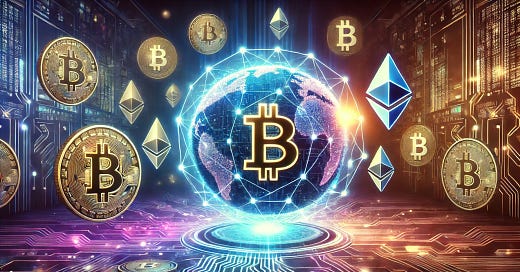“The illiterate of the future are not those who can’t read or write but those who cannot learn, unlearn, and relearn.”
— Futurist Alvin Toffler
This is what my book and my course is about. You don’t have to be technical but you do need to be curious.
We’re at a pivotal moment where blockchain and cryptocurrencies are reshaping our interactions with institutions, money, and technology. Understanding this evolving ecosystem is crucial, much like embracing personal computers in the '80s or the internet in the '90s.
Disintermediation: Blockchain’s Promise
Blockchain technology eliminates intermediaries, reducing friction across industries like banking, insurance, gaming, and online advertising. Entrepreneurs are driven by the vision of a more efficient world, identifying and fixing systemic inefficiencies such as:
Bank Transfers: Slow processing times and limited availability.
Stock Markets: Restricted to weekday operations.
Payment Processors: High profit margins (e.g., Visa, MasterCard).
From Skeuomorphic to Native Applications
Skeuomorphic apps enhance existing systems digitally, making them familiar to users. The next step is native blockchain applications, which fully leverage blockchain’s capabilities, driving innovation and broader adoption.
Key Components of the Crypto Ecosystem
Layer 2 DApps
Metaverse: Decentraland (MANA), The Sandbox (SAND)
Browsers: Brave (BAT)
DeFi & Lending: Aave, Compound
GameFi: Integrates gaming with decentralized finance
DAOs & NFTs: Decentralized governance and unique digital assets
Web3: Decentralized internet
Layer 1 Blockchains
Bitcoin: Digital gold and store of value
Ethereum & Ethereum 2.0: Smart contracts and decentralized apps
Avalanche, Solana, Polygon (MATIC): Enhanced scalability and speed
Layer 0 Interoperability
Polkadot (DOT), Chainlink (LINK): Bridges and oracles for cross-chain communication
Bitcoin and Beyond
Bitcoin is often criticized for lacking intrinsic value, but it's valued as digital gold due to its rarity and uncorrelation with fiat economies. Ethereum introduced smart contracts, expanding blockchain’s functionality but now faces scalability issues, paving the way for more advanced blockchains.
The Next Generation of Blockchain
Second-generation blockchains focus on solving scalability and efficiency issues, targeting specific use cases to add real value. Active developer communities, measured through platforms like GitHub, indicate a cryptocurrency’s potential and value.
Promising Tokens and Projects
Avalanche (AVAX)
AAVE
Chainlink (LINK)
Polkadot (DOT)
Solana (SOL)
Polygon (MATIC)
Brave Browser (BAT)
Uniswap
Key Considerations
When evaluating blockchains and tokens, consider:
Decentralization
Scalability
Security
Consensus Mechanism
Transparency
DAOs with AI could enhance governance by reducing partisanship and increasing efficiency.
Investing in Value-Driven Projects
Focus on projects that solve real problems and add utility, rather than just trading tokens. Infrastructure projects and those with strong developer support offer long-term value.
Conclusion
The crypto ecosystem is rapidly evolving, presenting immense opportunities for innovation and disruption. By understanding its components and focusing on value-driven projects, you can navigate and thrive in this new digital landscape. Embrace continuous learning and adaptability to stay ahead in the world of crypto.
Stay informed, stay curious, and embrace the journey of learning, unlearning, and relearning in the crypto world.
This is what my book and my course is about. You don’t have to be technical but you do need to be curious.
Thanks for reading,
John
If you are looking for bonus content to help you in your journey you can learn more here.
I am John Cousins, and I am proud to have had a diverse and accomplished career in multiple fields. My journey started with an electronics degree from MIT, which set the stage for my technical expertise and gave me the foundation I needed to succeed. From there, I went on to earn a BA from Boston University and an MBA from Wharton, which armed me with the business knowledge and skills I would need throughout my career.
I got my start in biotech, where I was fortunate enough to become the CEO of a company developing innovative cancer diagnostics. This role was just the beginning of my success in the corporate world, as I also served as the CFO of several public companies for 15 years and took two companies public during that time.
In addition to my corporate accomplishments, I have also been able to share my expertise and passion for business with others through writing and teaching. I have written a number of best-selling books on business topics, including "Patent It Yourself!", "Negotiation Communication Nation", "Reading and Understanding Financial Statements", and "MBA ASAP". I also founded MBA ASAP, an online business education community that provides individuals around the world with access to valuable business skills and knowledge.
For the past decade, I have been honored to share my experience and knowledge with students as a business teacher at universities and colleges. I am passionate about helping others achieve success in business, and I believe that my writing and teaching are a way for me to give back and make a positive impact.
Overall, I am grateful for the opportunities and experiences that have come my way, and I am proud of what I have been able to achieve. Whether it's through my corporate success, my writing, or my teaching, I am committed to making a difference in the business world and helping others succeed.
John Cousins MBA-ASAP Newsletter is a reader-supported publication. To receive new posts and support my work, consider becoming a free or paid subscriber.





